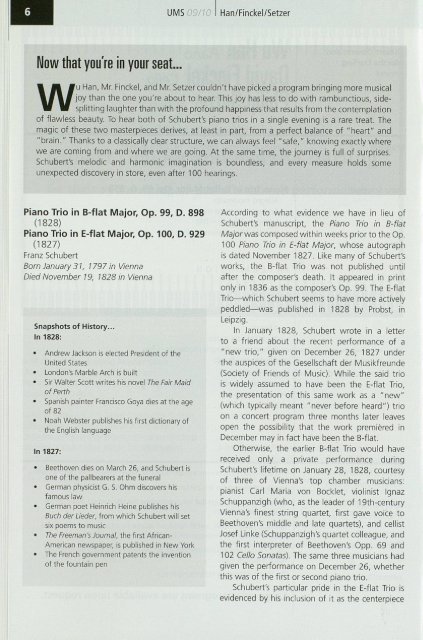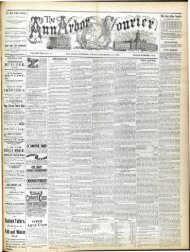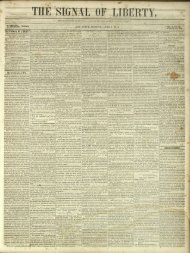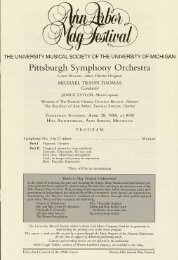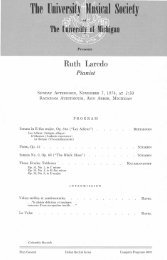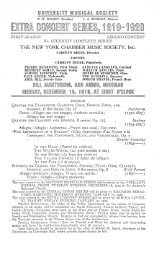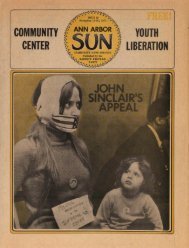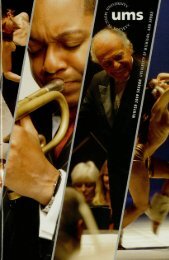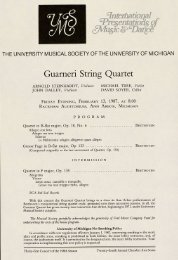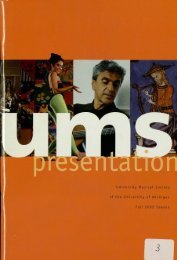university musical society - Ann Arbor District Library
university musical society - Ann Arbor District Library
university musical society - Ann Arbor District Library
Create successful ePaper yourself
Turn your PDF publications into a flip-book with our unique Google optimized e-Paper software.
Now that you're in your seat...<br />
UMS 09/1 Han/Finckel/Setzer<br />
Wu Man, Mr. Finckel, and Mr. Setzer couldn't have picked a program bringing more <strong>musical</strong><br />
joy than the one you're about to hear. This joy has less to do with rambunctious, side<br />
splitting laughter than with the profound happiness that results from the contemplation<br />
of flawless beauty. To hear both of Schubert's piano trios in a single evening is a rare treat. The<br />
magic of these two masterpieces derives, at least in part, from a perfect balance of "heart" and<br />
"brain." Thanks to a classically clear structure, we can always feel "safe," knowing exactly where<br />
we are coming from and where we are going. At the same time, the journey is full of surprises.<br />
Schubert's melodic and harmonic imagination is boundless, and every measure holds some<br />
unexpected discovery in store, even after 100 hearings.<br />
Piano Trio in B-flat Major, Op. 99, D. 898<br />
(1828)<br />
Piano Trio in E-flat Major, Op. 100, D. 929<br />
(1827)<br />
Franz Schubert<br />
Born January 31, 1797 in Vienna<br />
Died November 19, 1828 in Vienna<br />
Snapshots of History...<br />
In 1828:<br />
• Andrew Jackson is elected President of the<br />
United States<br />
• London's Marble Arch is built<br />
• Sir Walter Scott writes his novel The Fair Maid<br />
of Perth<br />
• Spanish painter Francisco Goya dies at the age<br />
of 82<br />
• Noah Webster publishes his first dictionary of<br />
the English language<br />
In 1827:<br />
• Beethoven dies on March 26, and Schubert is<br />
one of the pallbearers at the funeral<br />
• German physicist G. S. Ohm discovers his<br />
famous law<br />
• German poet Heinrich Heine publishes his<br />
Buch der Lieder, from which Schubert will set<br />
six poems to music<br />
• The Freeman's Journal, the first African-<br />
American newspaper, is published in New York<br />
• The French government patents the invention<br />
of the fountain pen<br />
According to what evidence we have in lieu of<br />
Schubert's manuscript, the Piano Trio in B-flat<br />
Major was composed within weeks prior to the Op.<br />
100 Piano Trio in E-flat Major, whose autograph<br />
is dated November 1827. Like many of Schubert's<br />
works, the B-flat Trio was not published until<br />
after the composer's death. It appeared in print<br />
only in 1836 as the composer's Op. 99. The E-flat<br />
Trio—which Schubert seems to have more actively<br />
peddled—was published in 1828 by Probst, in<br />
Leipzig.<br />
In January 1828, Schubert wrote in a letter<br />
to a friend about the recent performance of a<br />
"new trio," given on December 26, 1827 under<br />
the auspices of the Gesellschaft der Musikfreunde<br />
(Society of Friends of Music). While the said trio<br />
is widely assumed to have been the E-flat Trio,<br />
the presentation of this same work as a "new"<br />
(which typically meant "never before heard") trio<br />
on a concert program three months later leaves<br />
open the possibility that the work premiered in<br />
December may in fact have been the B-flat.<br />
Otherwise, the earlier B-flat Trio would have<br />
received only a private performance during<br />
Schubert's lifetime on January 28, 1828, courtesy<br />
of three of Vienna's top chamber musicians:<br />
pianist Carl Maria von Bocklet, violinist Ignaz<br />
Schuppanzigh (who, as the leader of 19th-century<br />
Vienna's finest string quartet, first gave voice to<br />
Beethoven's middle and late quartets), and cellist<br />
Josef Linke (Schuppanzigh's quartet colleague, and<br />
the first interpreter of Beethoven's Opp. 69 and<br />
102 Cello Sonatas). The same three musicians had<br />
given the performance on December 26, whether<br />
this was of the first or second piano trio.<br />
Schubert's particular pride in the E-flat Trio is<br />
evidenced by his inclusion of it as the centerpiece


